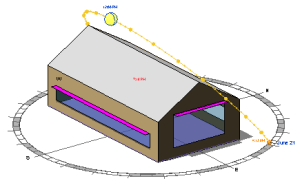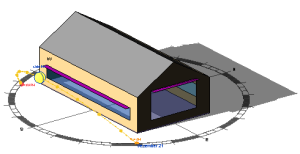The design requirements for a shading device depend on a building's use and local climatic conditions. In typical office buildings, for example, heating is rarely required because of the heat gains from people and equipment. In this case, it makes sense for the window shading to completely protect the windows year-round to avoid unwanted heat gain.
In residential projects, however, the shading may need to fully shade the windows during the summer months. In winter, the shading should expose windows as much as possible to direct sunlight to take advantage of the heat gain.
Use the Revit sun path tool or the Sun and Shadows Settings dialog to study the proposed shade depth for all orientations on Summer Solstice, Winter Solstice, Autumn Equinox, and Spring Equinox.
| In summer, shades prevent direct sunlight from entering the windows at noon. | In winter, shades do not prevent sunlight from penetrating the living space. |
 |
 |
Because of low sun angles, the east and west windows are difficult to shade with horizontal overhang devices. Consider vertical fins, louvers, and smaller window sizes for projects that need to reduce unwanted solar gain on these orientations.
For the purposes of Revit conceptual energy analysis, you must add these types of shading devices manually. Use mass surfaces attached to the mass model. In Revit, the shade material must be opaque to cast shadows.